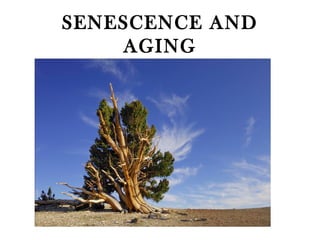
Senescence and aging plaphlec
- 1. SENESCENCE AND AGING
- 2. • SENESCENCE AND AGING • All living organisms have a definite life span. • A plant, be it annual or perennial has a vegetative growth phase after germination. • The formation of flowers or development of reproductive structures marks the arrival of reproductive phase. The plant becomes mature by this time. • With further passage of time its metabolic activities retard. • The functional activities slow down. • The plant becomes old and it reaches the senescence phase. Ultimately, the plant dies.
- 3. • Occasionally or seasonally, it has been observed that leaves and other organs fall down from the plant. • The process is called abscission and it is regular feature with all the perennial plants - Ageing, senescence and death
- 4. • The process of growing old is called ageing and death is the termination of functional life. • The stages of developmental processes that ultimately lead to death of an organ or organism is called senescence. This can be clearly observed in the plants having a short life span.
- 5. • Ageing is the sum total of changes occurring in the whole plant or some of its constituent organs. It includes all chemical and structural changes in cells, tissues, organs and the whole plant during their life cycle.
- 6. • Senescence is a consequence of ageing. Metabolic failure and cellular breakdown increase while the functional activities decrease during the senescence. • It occurs due to some highly ordered degenerative processes and lead ultimately to death. • Senescence is a highly ordered degenerative process and finally terminates the functional life of an organ or organism.
- 7. • Senescence in plants is manifested in various forms • 1. Whole plant senescence • The process of senescence begins with the reproductive maturity and the whole plant dies after seed production. It is a characteristic of monocarpic plant species which flower and fruit only once in their life cycle and as such senescence of whole plant occurs in them. This is seen is annuals and biennials.
- 8. • 2. Shoot Senescence • The aerial shoots only senesce and die every year after flowering. Its underground part (shoot and root) survive and form new shoots. Shoot senescence is seen in many perennials like Zingier, Musa, and Chrysanthemum etc.
- 9. • 3. Organ senescence • Here senescence of only lateral organs such as leaves and fruits occur and they die prior to the death of the whole plant. Organ senescence may be of the following type.
- 10. • (i) Simultaneous or synchronous This type of senescence is seen in the case of deciduous trees in which almost all leaves scenesce and fall more of less simultaneously at a particular season of the year. seasonal senescence
- 11. • (ii) Sequential senescence. It is a progressive senescence of the lower and older leaves while new ones are added to the growing shoot in a sequence. • Because the leaves have a limited life span, here, the senescence takes place in a sequential manner depending on the age of the leaf.
- 13. • Significance of Senescence • The process has many advantages in the cellular mechanism. • (i) Because of this, new, functionally efficient organs or organisms are created and the old, functionally inefficient are discarded. • (ii) It ensures recovery and reutilization of mineral elements and organic nutrients from older senescing organs to the newly formed growing organs.
- 14. • (iii) Synchronous or seasonal senescence avoids water loss due to transpiration during unfavorable season and thereby, helps in the survival of the plant. • (iv) Falling of leaves due to senescence adds to the humus content of the surface layer of the soil and thereby makes to soil reach in nutrients for germination and growth of new seedlings.
- 15. • http://www.biologyreference.com • http://www.preservearticles.com/201112191 8520/brief-essay-on-senescence-in- plants.html • http://www.therubins.com/aging/proc3.htm
